Practice Corner MCQs
Quiz Summary
0 of 53 Questions completed
Questions:
Information
You have already completed the quiz before. Hence you can not start it again.
Quiz is loading…
You must sign in or sign up to start the quiz.
You must first complete the following:
Results
Results
0 of 53 Questions answered correctly
Your time:
Time has elapsed
You have reached 0 of 0 point(s), (0)
Earned Point(s): 0 of 0, (0)
0 Essay(s) Pending (Possible Point(s): 0)
Categories
- Not categorized 0%
- 1
- 2
- 3
- 4
- 5
- 6
- 7
- 8
- 9
- 10
- 11
- 12
- 13
- 14
- 15
- 16
- 17
- 18
- 19
- 20
- 21
- 22
- 23
- 24
- 25
- 26
- 27
- 28
- 29
- 30
- 31
- 32
- 33
- 34
- 35
- 36
- 37
- 38
- 39
- 40
- 41
- 42
- 43
- 44
- 45
- 46
- 47
- 48
- 49
- 50
- 51
- 52
- 53
- Current
- Review
- Answered
- Correct
- Incorrect
-
Question 1 of 53
1. Question
Meristematic tissues are composed of
CorrectIncorrectHint
(d) Meristematic region is the region of active mitotic division in plants, from which permanent tissues are derived. It comprises of cells which are packed close to one another without any intercellular spaces. Meristematic cells are found in root and shoot tip regions.
-
Question 2 of 53
2. Question
In endarch condition of xylem, protoxylem lies ______ of metaxylem.
CorrectIncorrectHint
a
-
Question 3 of 53
3. Question
In (i), protoxylem lies towards periphery and metaxylem lies towards centre. Such an arrangement of primary xylem is called as (ii).
CorrectIncorrectHint
(d) In exarch condition of xylem, protoxylem or the first formed xylem is present towards the periphery while metaxylem or later formed xylem is present towards the centre. Such an arrangement can be seen in roots.
-
Question 4 of 53
4. Question
Which of the following conditions of xylem is present in both monocot and dicot stems?
CorrectIncorrectHint
(a) Based on position of protoxylem in relation to metaxylem, the xylem may be exarch/centripetal, endarch/centrifugal, mesarch and centerarch. In endarch condition, protoxylem lies on the inner side of metaxylem e.g., dicot and monocot stems.
-
Question 5 of 53
5. Question
Read the following statements and select the correct ones.
(i) Phloem parenchyma is absent in most monocots.
(ii) Gymnosperms lack tracheids and vessels.
(iii) Gymnosperms lack companion cells.CorrectIncorrectHint
(c) Phloem parenchyma is absent in most of the monocots and some herbaceous dicots. Gymnosperms lack companion cells, instead they possess albuminous cells. Gynmosperms lack vessels (except Gnetum etc.) but possess tracheids. Infact, tracheids constitute \(90-95 \%\) of wood in gymnosperms.
-
Question 6 of 53
6. Question
Select the incorrect pair out of the following.
CorrectIncorrectHint
(d) Phloem is a complex permanent tissue that transports organic food inside the plant. Xylem is a complex permanent tissue that performs the function of ascent of sap i.e., transport of inorganic nutrients (water and minerals) within the plant.
-
Question 7 of 53
7. Question
A common structural feature of vessel elements and sieve tube elements is
CorrectIncorrectHint
(a) Xylem vessels become dead and lose their protoplasm due to deposition of lignified secondary wall. Mature sieve tube elements are living cells without nucleus.
-
Question 8 of 53
8. Question
Identify the types of vascular bundle in the given figures (i) and (ii) and select the correct option.
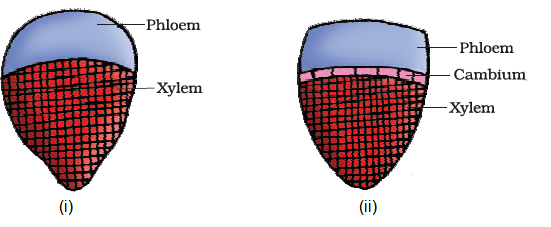 CorrectIncorrect
CorrectIncorrectHint
c
-
Question 9 of 53
9. Question
Select the mismatched pair.
CorrectIncorrectHint
(c) Trichomes are unicellular or multicellular, branched or unbranched outgrowths which are strictly epidermal in origin. Being the outermost layer trichome is protective in nature. With the help of cuticle it checks the rate of water loss from aerial parts. Trichomes present on the surface of some seeds and fruits help in their dispersal.
-
Question 10 of 53
10. Question
Given figures ( P and Q ) represent the stomatal apparatus of dicot and monocot leaves, respectively. Select the option which correctly labels A, B and C.
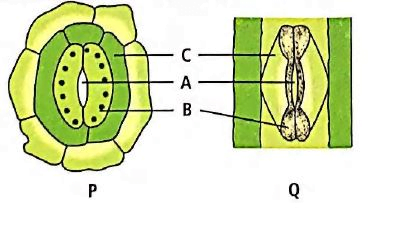 CorrectIncorrect
CorrectIncorrectHint
d
-
Question 11 of 53
11. Question
Identify the plants (from the list i – vi) which possess the given type of guard cells (as shown in the diagram) in their leaves.
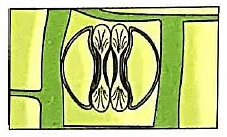
(i) Grass
(ii) Tomato
(iii) Banana
(iv) Brinjal
(v) Soybean
(vi) LilyCorrectIncorrectHint
(c) The guard cells shown in the figure are dumb-bell shaped guard cells. These are mainly found in monocots such as grasses, banana and lily.
-
Question 12 of 53
12. Question
Epidermal tissue system is derived from
CorrectIncorrectHint
(a) Protoderm (Gk. protos-first, derma-skin) is the outer layer of apical meristem that gives rise to epidermal tissues. Epidermal tissue system is derived from protoderm. Ground tissue system is derived partly from periblem and partly from plerome. Vascular tissue system is derived from procambium.
-
Question 13 of 53
13. Question
Three types of tissue system have been recognised in plants on the basis of their functions. Select the correct option regarding this.
CorrectIncorrectHint
d
-
Question 14 of 53
14. Question
Read the given paragraph where few words are underlined. Select the option that correctly replaces the underlined words (if necessary).
The epidermal tissue system forms the innermost covering of whole plant body. Epidermis is usually multilayered and consists of pores called stomata. Each stoma is composed of two subsidiary cells which lack chloroplast and regulate opening and closing of stomata. Few cells in the vicinity of subsidiary cells get specialised to form guard cells.CorrectIncorrectHint
b
-
Question 15 of 53
15. Question
Which of the following tissue systems constitutes bulk of the plant body?
CorrectIncorrectHint
(b) Ground tissue system includes all the tissues of plant body except epidermal tissue system and vascular tissues. It forms the bulk of body and consists of mainly parenchymatous, collenchymatous, sclerenchymatous, glandular and laticiferous tissues.
-
Question 16 of 53
16. Question
In ____ vascular bundle, a strip of vascular cambium is present in between the xylem and phloem.
CorrectIncorrectHint
(a) In gymnosperms and dicot stems, a strip of vascular cambium occurs between phloem and xylem of each vascular bundle. It is called intrafascicular (or fascicular) cambium. This strip of vascular cambium later produces secondary tissues. Such vascular bundles are described as open.
-
Question 17 of 53
17. Question
Radial vascular bundles characteristically occur in
CorrectIncorrectHint
(c) In roots, xylem and phloem bundles are arranged in an alternate manner on different radii, i.e., radial vascular bundles.
-
Question 18 of 53
18. Question
Identify the type of vascular bundle as shown in the figure and select the incorrect statement regarding it.
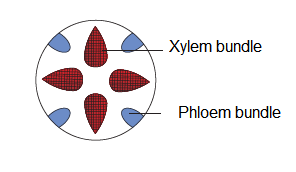 CorrectIncorrect
CorrectIncorrectHint
(c) The given figure represents radial vascular bundles. Here xylem and phloem occur in the form of separate bundles called xylem bundles and phloem bundles. The two types of bundles usually alternate with each other. They occur on different radii. Radial bundles are characteristic of monocot and dicot roots.
-
Question 19 of 53
19. Question
Which of the following is an incorrect pair?
CorrectIncorrectHint
(c) In amphistomatic condition, both the surfaces of leaf contain stomata.
-
Question 20 of 53
20. Question
Casparian strips are the bands of thickenings present on ____ walls of endodermis.
CorrectIncorrectHint
(d) Endodermis is the innermost layer of cortex that consists of tightly packed barrel-shaped cells. It is called starch sheath in case of dicot stems. Radial and tangential walls of endodermal cells possess thickenings of lignin, suberin and cutin in the form of strips or bands, which are known as Casparian bands or Casparian strips.
-
Question 21 of 53
21. Question
A diagram of T.S. of dicot root is given. Select the option which correctly labels A, B, C, D, and E.
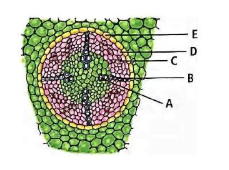 CorrectIncorrect
CorrectIncorrectHint
b
-
Question 22 of 53
22. Question
Stele includes
CorrectIncorrectHint
(d) Word ‘stele’, is taken from Greek language, which means ‘pillar’. Stele consists of pericycle, vascular bundles (xylem and phloem) and pith (if present).
-
Question 23 of 53
23. Question
Transverse section of a part of a typical monocotyledonous root has been shown in the given figure. Identify the different parts (from A to l) and select the correct option.
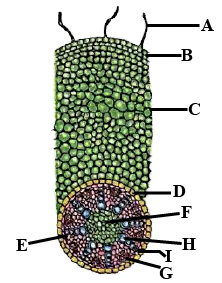 CorrectIncorrect
CorrectIncorrectHint
(a)
-
Question 24 of 53
24. Question
Polyarch vascular bundles generally occur in
CorrectIncorrectHint
(d) Vascular bundles in monocot roots are radial, polyarch and exarch. Large number (more than 6 ) of xylem and phloem groups alternate with each other. A well developed pith is present in monocot root.
-
Question 25 of 53
25. Question
A typical monocotyledonous root is characterised by
CorrectIncorrectHint
(d) There is no distinction between a young and an old root of monocotyledonous plant. This is due to the absence of secondary growth in the monocot roots. The centre of monocot root is occupied by the pith. It consists of parenchymatous cells which may be rounded or angular. Intercellular spaces are present amongst the pith cells. The pith cells store food. Xylem and phloem bundles are numerous and are 8 or more in number.
-
Question 26 of 53
26. Question
Following table summarises the differences between a monocot root and a dicot root.
\(
\begin{array}{|c|l|l|l|}
\hline & \text { Characters } & \text { Monocot root } & {\text { Dicot root }} \\
\hline \text { (i) } & \begin{array}{l}
\text { Vascular } \\
\text { bundle }
\end{array} & \begin{array}{l}
\text { Polyarch, i.e., } \\
\text { more than } 6 \\
\text { vascular bundles }
\end{array} & \begin{array}{l}
\text { Diarch to } \\
\text { hexarch, i.e., } \\
2-6 \text { vascular } \\
\text { bundles }
\end{array} \\
\hline \text { (ii) } & \text { Cambium } & \text { Absent } & \begin{array}{l}
\text { Present, so } \\
\text { secondary } \\
\text { growth occurs }
\end{array} \\
\hline \text { (iii) } & \text { Pith } & \begin{array}{l}
\text { Poorly } \\
\text { developed }
\end{array} & \begin{array}{l}
\text { Well } \\
\text { developed } \\
\text { large pith }
\end{array} \\
\hline \text { (iv) } & \begin{array}{l}
\text { Activity of } \\
\text { pericycle }
\end{array} & \begin{array}{l}
\text { Gives rise to } \\
\text { secondary } \\
\text { roots and cork } \\
\text { cambium }
\end{array} & \begin{array}{l}
\text { Gives rise to } \\
\text { lateral roots } \\
\text { only }
\end{array} \\
\hline
\end{array}
\)Identify the incorrect differences and select the correct option.
CorrectIncorrectHint
(c) In monocot root, a well developed pith is present whereas in dicot root, pith is poorly developed. In monocot root, pericycle gives rise to lateral roots only whereas in dicot root, pericycle gives rise to secondary roots and cork cambium.
-
Question 27 of 53
27. Question
Read the following statements.
(i) Multicellular epidermal hair
(ii) Collenchymatous hypodermis
(iii) Pith present
(iv) Vascular bundles present in a ring i.e., eustele Above given features describe which of the following plant parts?CorrectIncorrectHint
(c) The epidermis of dicot stem bears several unbranched multicellular hair or trichomes. The hypodermis is made of 3-4 layered sub-epidermal collenchyma tissue. Vascular strand is in the form of eustele or a ring of vascular bundles present around the central pith and inner to the pericycle.
-
Question 28 of 53
28. Question
Read the following statements and select the correct option.
Statement 1 : Anatomically, all the tissues present on the inner side of endodermis such as pericycle, vascular bundles and pith constitute the stele.
Statement 2 : Eustele is the stele in which vascular bundles are arranged in the form of a ring as present in dicot stems.CorrectIncorrectHint
a
-
Question 29 of 53
29. Question
Read the following statements with 1-2 blanks in each one of them.
(i) In monocot root, a large number of vascular bundles are arranged in the form of a ____ around the central ____.
(ii) Due to the presence of ____, the endodermal cells do not allow wall to wall movement of substances between cortex and pericycle, in a primary dicot root.
(iii) The epidermis of stem of sunflower bears several unbranched _____ hair.
(iv) The central portion of a dicot stem is usually occupied by _____ parenchymatous cells. comprising of thin-walled
Select the option that correctly fills the blanks in any two of them.CorrectIncorrectHint
(d)
-
Question 30 of 53
30. Question
Vascular bundle is enclosed within a well developed sclerenchymatous sheath in
CorrectIncorrectHint
(a) In most monocot stems, a sclerenchymatous bundle sheath is generally present on the outside of each vascular bundle.
-
Question 31 of 53
31. Question
Hypodermis is ____ in sunflower stem and ____ in maize stem.
CorrectIncorrectHint
(b) In sunflower, hypodermis is made up of collenchyma, which may be green. In maize, hypodermis is formed of non-green sclerenchyma tissue.
-
Question 32 of 53
32. Question
Well developed pith is found in
CorrectIncorrectHint
(C) In a dicot stem, a well developed pith (made of parenchymatous or occasionally sclerenchymatous cells) is present whereas in a monocot stem, pith is absent. In a dicot root, pith is poorly developed whereas in a monocot root, a well developed pith is present.
-
Question 33 of 53
33. Question
Select the incorrect statement regarding the anatomy of a typical monocotyledonous stem.
CorrectIncorrectHint
(d) Ground tissue of a monocot stem is a mass of similar cells which does not show distinction into cortex, endodermis, pericycle, pith, etc.
-
Question 34 of 53
34. Question
Figures X and Y represent the transverse sections of ____ and _____ respectively.
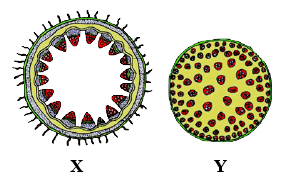 CorrectIncorrect
CorrectIncorrectHint
c
-
Question 35 of 53
35. Question
Select the mismatched pair.
CorrectIncorrectHint
(b) Bicollateral vascular bundles have phloem both on the outer and inner side of xylem. All the three lie on the same radius. Usually a strip of vascular cambium is present on both outer and inner sides of xylem. Bicollateral vascular bundles occur in Cucurbitaceae (e.g., Pumpkin or Cucurbita pepo, Ridge gourd or Luffa cylindrica) and some members of families Solanaceae, Convolvulaceae, etc.
-
Question 36 of 53
36. Question
Bicollateral vascular bundles are found in
CorrectIncorrectHint
(c) Bicollateral vascular bundles have phloem both on the outer and inner side of xylem. All the three lie on the same radius. Usually a strip of vascular cambium is present on both outer and inner sides of xylem. Bicollateral vascular bundles occur in Cucurbitaceae (e.g., Pumpkin or Cucurbita pepo, Ridge gourd or Luffa cylindrica) and some members of families Solanaceae, Convolvulaceae, etc.
-
Question 37 of 53
37. Question
Y- shaped arrangement of xylem vessels is found in
CorrectIncorrectHint
a
-
Question 38 of 53
38. Question
Which plant part possesses polyarch condition of vascular bundles with a well developed pith?
CorrectIncorrectHint
b
-
Question 39 of 53
39. Question
Refer to the given figure which represents a section of vascular bundle as seen in.T.S. of a monocot stem and select the option that correctly labels A, B, C and D.
 CorrectIncorrect
CorrectIncorrectHint
c
-
Question 40 of 53
40. Question
In a dorsiventral leaf, location of palisade tissue and phloem is respectively on the ____ surfaces.
CorrectIncorrectHint
(a) Dorsiventral (bifacial) leaves are commonly horizontal in orientation with distinct upper (adaxial) and lower (abaxial) surfaces. Mesophyll is distinguishable into palisade and spongy tissues with palisade usually restricted to the upper (adaxial) side. Vascular bundles are conjoint and collateral i.e., they possess both xylem and phloem which lie on the same radius. Xylem lies towards the upper (adaxial) side of leaf while phloem lies towards the lower (abaxial) side of leaf. Most of the dicotyledonous leaves are dorsiventral.
-
Question 41 of 53
41. Question
The given figure shows T.S. of Helianthus leaf with various parts labelled as A, B, C, D, E and F. Identify the parts and select the correct option.
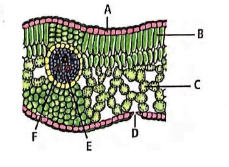 CorrectIncorrect
CorrectIncorrectHint
d
-
Question 42 of 53
42. Question
Identify A, B, C and D in the given transverse section of leaf of Zea mays.
 CorrectIncorrect
CorrectIncorrectHint
b
-
Question 43 of 53
43. Question
In a dorsiventral leaf, what is true regarding the position of xylem?
CorrectIncorrectHint
(a) Dorsiventral (bifacial) leaves are commonly horizontal in orientation with distinct upper (adaxial) and lower (abaxial) surfaces. Mesophyll is distinguishable into palisade and spongy tissues with palisade usually restricted to the upper (adaxial) side. Vascular bundles are conjoint and collateral i.e., they possess both xylem and phloem which lie on the same radius. Xylem lies towards the upper (adaxial) side of leaf while phloem lies towards the lower (abaxial) side of leaf. Most of the dicotyledonous leaves are dorsiventral.
-
Question 44 of 53
44. Question
Bundle sheath extensions in a dicot leaf and in a monocot leaf are and
CorrectIncorrectHint
(b) In dicot leaf, each vascular bundle is surrounded by a sheath of compactly arranged cells called bundle sheath. Bundle sheath extensions are parenchymatous. In monocot leaf, larger vascular bundles bear bundle sheath extensions. Bundle sheath extensions are sclerenchymatous and provide mechanical strength to the leaf.
-
Question 45 of 53
45. Question
Select the correct pair out of the following.
CorrectIncorrectHint
(a) In dicot leaves, stomata are generally present on lower epidermis (hypostomatic), whereas in monocot leaves, they are present on both the surfaces (amphistomatic). In free-floating hydrophytes, stomata are restricted to upper epidermis (epistomatic) whereas in submerged hydrophytes, stomata are either nonfunctional or absent. In algae and fungi, stomata are totally absent. Stomata are sunken (deep seated) in case of xerophytes.
-
Question 46 of 53
46. Question
Study the following statements regarding the anatomy of isobilateral leaf.
(i) Stomata are equally distributed on both the surfaces.
(ii) Certain adaxial epidermal cells are modified into bulliform cells in grasses.
(iii) The vascular bundles are radial.
(iv) Phloem is adaxially placed.
Which of the above statements are correct?CorrectIncorrectHint
(a) In an isobilateral (equifacial) ‘leaf, vascular bundles are conjoint and collateral. Xylem lies towards the adaxial (upper) side and phloem lies towards abaxial (lower) side of leaf.
-
Question 47 of 53
47. Question
Increase in girth of the plant as a result of the activities of primary and secondary lateral meristems is called
CorrectIncorrectHint
(c) Increase in girth or thickness of the axis of plant takes place due to the activity of secondary lateral meristems like vascular cambium and cork cambium. It is called secondary growth.
-
Question 48 of 53
48. Question
In dicot stems, cambium present between primary xylem and primary phloem is
CorrectIncorrectHint
(d) Intrafascicular or fascicular cambium is present in the form of a narrow strip of primary meristematic cells in between the phloem and the xylem of a vascular bundle. Intrafascicular cambium is primary lateral meristem which helps in increasing girth of the plant.
-
Question 49 of 53
49. Question
In a mature dicot stem which has undergone secondary growth, youngest layer of secondary xylem is situated
CorrectIncorrectHint
(c) The cambial ring present between primary xylem and primary phloem becomes active and begins to cut off new cells, both towards the inner and the outer sides. The cells cut off towards pith mature into secondary xylem and the cells cut off towards periphery mature into secondary phloem.
-
Question 50 of 53
50. Question
Which of the following statements is incorrect?
CorrectIncorrectHint
(c) Each mature sieve tube element has thin or thick cellulose wall surrounding a highly albuminous and viscous content. Cytoplasm occurs in the form of thin lining enclosing a big central vacuole. The nucleus, plastids, mitochondria, endoplasmic reticulum and dictyosomes are absent. Vacuole is filled with albuminous substances.
-
Question 51 of 53
51. Question
Match column I with column II and select the correct option from the given codes.
\(
\begin{array}{|c|l|c|l|}
\hline & \text { Column I } & & \text { Column II } \\
\hline \text { A. } & \text { Bulliform cells } & \text { (i) } & \begin{array}{l}
\text { Regulate opening and } \\
\text { closing of stomata }
\end{array} \\
\hline \text { B. } & \text { Guard cells } & \text { (ii) } & \begin{array}{l}
\text { Aerating pores in the bark } \\
\text { of plant }
\end{array} \\
\hline \text { C. } & \text { Lenticels } & \text { (iii) } & \begin{array}{l}
\text { Rolling in and out of } \\
\text { leaves }
\end{array} \\
\hline \text { D. } & \text { Subsidiary cells } & \text { (iv) } & \text { Accessory cells } \\
\hline
\end{array}
\)CorrectIncorrectHint
a
-
Question 52 of 53
52. Question
Consider the following statements regarding the given figure and select the correct one.
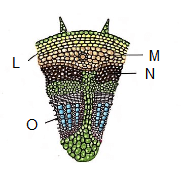 CorrectIncorrect
CorrectIncorrectHint
(a) ‘ M ‘ is the endodermis, which is the innermost layer of cortex and usually lacks Casparian strips in a dicot stem. ‘ N ‘ is the sclerenchymatous pericycle that provides mechanical strength. ‘ O ‘ is xylem which is endarch (centrifugal) i.e., protoxylem (first formed xylem) lies towards the pith or centre of the stem.
-
Question 53 of 53
53. Question
Given are a few peculiar parts/structures found in plants. Cucurbita stem, potato tuber, walnut shell, jute fibres. Identify the tissue responsible for the distinguishing feature in each part respectively and select the correct option.
CorrectIncorrectHint
(a) Cucurbita stem contains collenchymatous hypodermis which provides it mechanical strength and elasticity. Potato tuber contains storage parenchyma to store reserve food. Walnut shell possesses sclereids and jute fibres characteristically contain phloem fibres (sclerenchymatous fibres).